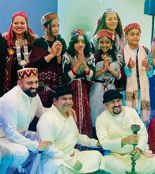Anand Nilakantan
Book Title: Valmiki’s Women: Five tales from the Ramayana
Author: Anand Neelakantan
Tribune News Service
Amritsar, November 15
Majha House invited renowned author Anand Neelakantan for an online session on Monday. In conversation with columnist Pratyaksha, the discussion centred around his latest book ‘Valmiki’s Women: Five tales from the Ramayana’.
Introducing the speakers, Preeti Gill, founder, Majha House, said: “Anand is a much respected and loved author and his fame rose to unprecedented heights, when he wrote the ‘Bahubali’ trilogy, the prequel to SS Rajamouli’s mega blockbuster. What makes his books unique is that he tries to project a well-known story from a different perspective. In his latest book, he’s taken five tales from the Ramayana to highlight the roles and importance of women in Valmiki’s epic, which makes us look at these characters in a new light.”
These are tales of love, courage and devotion, which hold the epic together, said Pratyaksha. Talking about his books, Anand said he has always been interested in mythology and seeing traditional things in a new light and gaining a new perspective is always interesting. “Retelling an epic from the point of view of another character is deeply fascinating. Asura, for instance, tells the story from Ravana’s point of view. Since the epics are retold and re-imagined hundreds of times, characters, too, change according to the cultural context. The demure Sita is not Valmiki’s Sita, who is a rebel. She is a strong character: she leaves the palace with Rama; she becomes a single mother. Thus, she is a far more interesting and complex character than say Urmila for instance,” he said.
He said it was rather unfortunate that in retelling an epic many characters are reduced to stereotypes and lose depth. “In forwarding a simplistic narrative, we reduce things to just opposites like good versus evil, hero versus villain. But what is important for me is that this is not a story about gods but human beings, all of whom have their faults. This makes them more relatable,” Ananda stressed. Talking about ‘Valmiki’s Women’, Ananda said: “When we think of the Ramayana, what we tend to forget is that there are many important female characters in the epic, who shape the story. There is Sita, of course, but Manthara, Meenakshi and Shanta all play an important role and contribute to the epic.” He emphasised that in projecting a different perspective, it is not his intention to offer a justification or explanation, but to give just a point of view.
“What I also find fascinating is that many writers offer many different versions of the same story adding to the complexity of the narrative. In one version, Sita is happier in the forest than in the palace upon their return because Rama has become too involved in the affairs of the state and Sita feels neglected. For her, her time in the forest is more romantic,” he laughed.














